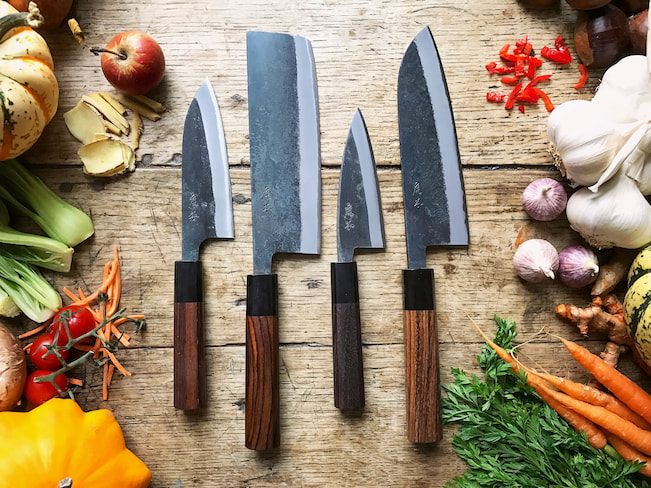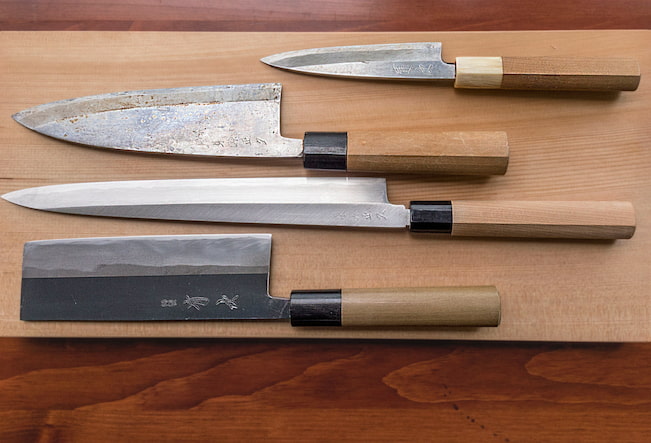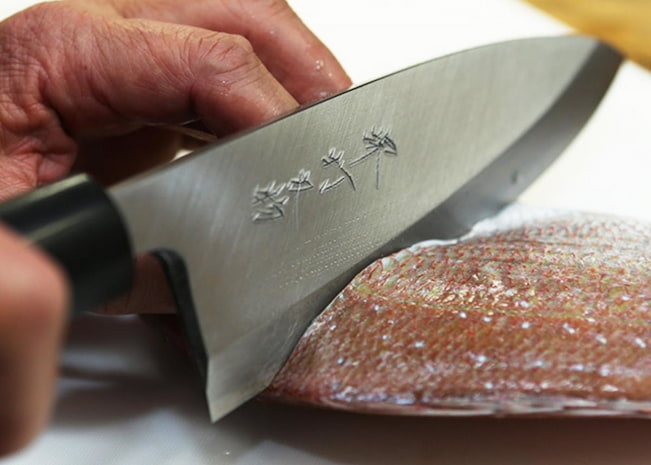Everyone who loves cooking understands the value of making the appropriate tool purchases to support their culinary skills. First and foremost, on that list, besides cookware, would be having high-quality knives, as there is nothing worse than preparing a meal with a blunt knife. Not only is it potentially harmful, but it also results in components that are haphazardly chopped and can bruise fresh fruit, hastening the rate at which it degrades. So, if you want to upgrade your kitchen arsenal with a good knife set, there is nothing better than a Japanese one!
Why Choose Japanese Knives?
Discover the pleasure of cooking and make every cut a breeze with high-performance Japanese kitchen knives made of high-quality materials and authentic designs. Their growing popularity in recent years is due to the lesser need for sharpening and the better results in the kitchen.

Another characteristic that sets these unique blades apart is their weight. You can hold them for a longer period because they are lighter, feel more balanced in your hands, and have a firm, thin steel edge.
Any Japanese knife type you invest in will speed up the food prep process while offering unrivalled precision. That’s why they are particularly popular among professional chefs who labour in the kitchen for hours on end.
However, with so many options available, the process of choosing the right Japan knife for the first time can be tricky. To make the purchase a whole lot easier, take the following buying factors into account.
Common Types
Unlike Western knives which are known for their versatility, Japanese ones are made for specific tasks. One of the most common types of knives and equivalent of a traditional Western Chef’s knife is the Gyuto.
Its edge has a gradual bend toward the point that makes it perfect for cutting tougher items in a rocking motion, such as fruit and vegetables. Additionally, it is tall enough to provide a good surface contact. As a result from the blade’s design there’s less user fatigue which allows for more contact with the cutting surface.
The Gyuto comes in a variety of lengths and is sharp on both sides. It’s lightweight and excels at precise tasks like chopping up light vegetables and proteins. However, you would struggle with it when cutting through tough veggies and fruit.

Another great Japanese kitchen knife favourite among professionals is the Santoku. This large and multi-purpose knife is a real workhorse! It works great with meat, fish and vegetables as well as allows for three different cutting techniques: slicing, dicing and chopping. You can utilize it in almost any recipe that comes to your mind.
Vegans will however love the utility of the Nakiri as it is best used for cutting vegetables. This type of Japanese kitchen knives features a thin and wide blade and squared-off tip. Nakiri is excellent for julienne, brunoise allumette, and other fine knife cuts for vegetables because of its straight blade. It is also a fantastic tool for slicing through vegetables with extremely tough skin, such as pumpkins and squash.
High Carbon or Stainless Steel
Speaking of materials, the key decision you have to make is whether to choose a blade made of high-carbon steel or a blade made of non-high-carbon (stainless) steel. An excellent stainless-steel blade has good corrosion resistance, is simple to maintain, and keeps its edge well. Due to its properties, novice to intermediate users have begun to favour them more and more.
A high-carbon steel blade, on the other hand, is a higher-grade stainless-steel alloy with a certain percentage of carbon. It was constructed to fuse the greatest qualities of carbon steel and common stainless steel. In other words, the high-carbon stainless steel blades keep their edge for a respectable amount of time without fading or staining.
Hardness
Hardness is the capacity to withstand deforming when stressed and submitted to external forces. The Rockwell C scale, sometimes known as “HRC” is typically used to quantify hardness in knife steels, which is frequently referred to as strength. Most stainless-steel knives do not keep their edge properly, as was described in the previous section.

This is not the case, though, if the steel has undergone heat treatment or other forms of hardening, resulting in a Rockwell rating of at least 56 or 58. Choose a stainless-steel knife that has been hardened to 56/58 or above on the HRC scale if you’re buying one. It will quickly lose its edge if it is any less than this!
Handles and Angles
The handle’s shape is crucial in terms of the knife’s balance, how it feels in your hand, and ultimately how it performs. You must be at ease using your knife because doing so makes it simpler to operate. It will hurt and be challenging for you to control the knife if the handles are too big or too little for your hands.
Western-style and Japanese-style handles are both available for Japanese knives. The former is thicker, feels sturdier, and is better suited for demanding cutting tasks. The latter has historically been lighter, cylindrical, or octagonal, and always made of wood. The knife feels lighter and nimbler in your hand thanks to this classic design. For instance, a knife’s beauty is greatly enhanced by a sturdy, stylish, and high-quality wooden handle.
The term “the bevel” is also used to describe a knife’s angle. Due to the double bevel on European knives, the blade is honed on both sides. Traditional Japanese kitchen knives on the other hand only have a single bevel, meaning that one side of the blade—typically the right side—is sharpened while the other is entirely straight. They are more suitable for professional chefs, as they are built for highly precise cuts and have a variety of purposes.
Maintenance and Protection
Knives require a little tender loving care, just like most equipment. Regular sharpening is needed, and depending on the type of steel, you should dry them right away after usage. Also, never put your knife in a dishwasher. Knives should be kept sheathed in the utensil drawer or on the magnetic knife strip. To remove the food you just chopped, do not slide your knife across the chopping board with the blade down.


























